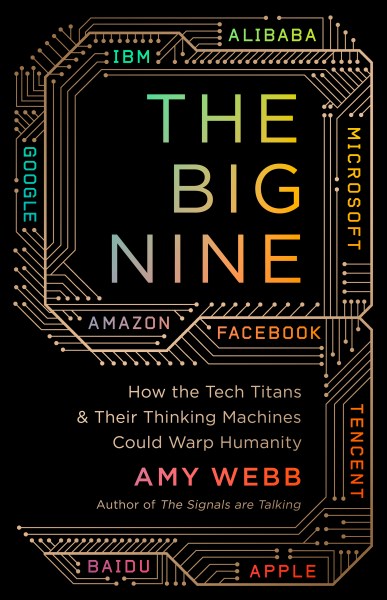testsetset
The year is 2023, and Google, Microsoft, and other influential AI companies are joining an international coalition of businesses and democratic governments to declare AI a public good.
Using China’s AI strategy as motivation, teachers preparing people for an automated future are paid more, and federal funding for AI projects grows so big it relieves the Googles of the world from obsessing over AI advances in order to meet shareholder demands.
“We stop assuming that the G-MAFIA (Google, Apple, Facebook, IBM, and Amazon) can serve its DC and Wall Street masters equally and that the free markets and our entrepreneurial spirit will produce the best possible outcomes for AI and humanity,” author Amy Webb writes.
In this future, democratically elected governments around the world begin to focus on AI for the good of all. As a result of increased international cooperation, economic pressure is placed on governments that use AI for surveillance and enabling of authoritarian governments, ultimately forcing them to adopt transparency and openness in AI systems.
June 5th: The AI Audit in NYC
Join us next week in NYC to engage with top executive leaders, delving into strategies for auditing AI models to ensure fairness, optimal performance, and ethical compliance across diverse organizations. Secure your attendance for this exclusive invite-only event.
These are all scenarios considered in The Big Nine, a book out today by Webb, a futurist and director of the Future Today Institute at New York University’s Stern School of Business. She has spent years advising tech companies and governments in an attempt to answer everyone’s biggest question: What happens next?
In The Big Nine, Webb seeks to answer this question for the next 50 years. She views the world through the influence of the titular big nine: Google, IBM, Microsoft, Amazon, Facebook, and Apple in the United States, and Alibaba, Baidu, and Tencent in China.
In her annual tech trends report a year ago, Webb articulated that these nine companies have the most control over cloud computing, research, data, and the popular frameworks used by developers and will therefore shape the future of AI.
The 2019 Emerging Tech Trends report is due out Saturday.
Thanks to companies like Baidu, Alibaba, and Tencent, China is already poised to become the world’s unchallenged AI hegemon, a development Webb isn’t sure is good for the future of humanity.
Given the broad powers these companies have gathered from billions of users around the world and many national governments, some of the scenarios she imagines don’t seem all that far-fetched.
Best-case and worst-case scenarios
An ideal future for AI is one in which tech companies work with each other and society to solve the world’s problems. In this scenario, Webb even envisions IBM helping rid the world of the common cold. In pragmatic and worst-case scenarios, however, the major tech companies shirk their responsibility to society and the future in favor of profit.
In this version, digital caste systems emerge in which access to your personal data is locked in the operating systems of tech giants like Google, Apple, and Amazon. Webb imagines that Amazon never has another AI-powered device success as great as the Echo and in the 2020s joins forces with Apple to create a common operating system named Applezon.
Large corporations will be run by CAIOs — chief AI officers — and there will be no cooperation between government, military, and tech leaders.
Amazon ends up owning low-income public housing in the United States as these large companies take on more government contracts.
Worse still is when we begin to transition from artificial narrow intelligence (ANI), which can complete a limited range of tasks, to artificial general intelligence (AGI).
In this scenario, Webb envisions China creating an AGI system that controls most of the world’s population; in the Digitally Occupied States of America, China controls your bank account.
In 50 years, as the world population surpasses 10 billion and superintelligent AI emerges, China creates a system to exterminate its foes and take what’s left of the world’s resources, ending democracy and the United States.
Some of the scenarios in The Big Nine, especially in the worst-case scenario portion of the book, begin to sound more like science fiction than a future you can envision playing out.
To be fair, today we’re struggling with the idea that generative adversarial networks can create images indiscernible from real people, and national governments are still formulating AI strategies in an effort to combat bias and injustice. So any vision decades into a future where businesses and government deploy powerful ML systems without much regard for their impact is going to look pretty strange.
Finishing thoughts
I went into this book with the idea that I might get a one-by-one breakdown of each of these companies’ present AI strategies and a sense of the way things could be heading in a decade or two.
That’s not exactly how it turned out. The book is more a summary of what could play out between the biggest tech companies on Earth, an approach that paints a clear overarching picture but doesn’t make it easier to see how each company could redefine the future of work and government and health care.
If you are steeped in the history of AI and conversations about where projects and products with machine learning could lead, Part One may repeat information you already know about challenges currently facing the AI community and major milestones that have led us to the present day.
What I enjoyed about this book is that instead of predicting the future, Webb lays out scenarios for optimistic, pragmatic, and catastrophic outcomes — all extrapolated from current facts. However impractical you may find the idea of a common Apple-Amazon operating system named Applezon, considering potential scenarios is a fantastically healthy exercise, because anyone who tells you they know how AI is going to turn out is lying.
AI has been around since the 1950s, but the intelligent machines made possible by advances in computing in the past decade are relatively new. Taking the set of facts available to us today and considering the possibilities allows people to prepare for potential outcomes and take into account the impact of domination by these companies.
Unlike work that centers on technical advances or the science fiction dreams of Black Mirror, Webb’s look 10 or 20 years into our future combines her learnings from Future Today Institute Research and her experience advising businesses and the military about tech and AI.
This cross-disciplinary background allows her to take into account factors like international politics, behavioral science, and game theory when exploring the good and bad potential of intelligent systems let loose on society.
And Webb spends Part Three of the book exploring potential solutions, such as weaving ethics into the education of AI practitioners and revising the Office of Technology Assessment to advise members of Congress whose policy initiatives will impact AI.
One gripe: I expected to hear more about how this future will look for each of these big companies. If you’re noticing Baidu, Tencent, and Alibaba have been passed over here, it’s because the book makes little attempt to imagine how they fit into the big picture of any of these scenarios and instead focuses on the Chinese government’s efforts to build a new Silk Road to Europe and proliferate devices that collect data and control people.
Overall, however, I found The Big Nine to be an accessible and constructive imagining of what could come next.
You don’t have to be a machine learning engineer capable of training and deploying AI systems from scratch to understand why the subjects explored in the book matter and why it’s a conversation that belongs to everyone, not just people working in AI.
These companies already touch the lives of a large percentage of the global population and, as Webb puts it, are shaping the structure of systems and frameworks that will touch everyone’s lives.
At the start of the book, Webb asserts, “The Big Nine aren’t the villains in this story. In fact, they are our best hope for the future.” Given some of the events in the past year of techlash, I can see why some people may take issue with that statement, but there’s no denying that the steps taken by massive AI-first companies in the present day will shape our future, for better or worse.



